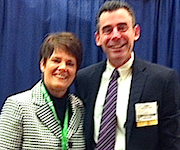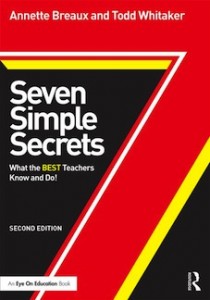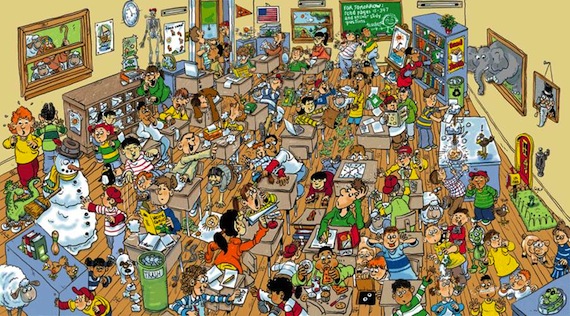What an Effective Teacher’s Classroom Looks Like
 by Annette Breaux and Todd Whitaker
by Annette Breaux and Todd Whitaker
In our ongoing observations of teachers, we continue to notice that the most effective teachers’ classrooms all look uncannily similar. And, of course, the same can be said for the less effective teachers—their classrooms all look uncannily similar.
It seems that no matter where we go, the students all act the same in the classrooms of the most effective teachers. And yes, no matter where we go, the students all act the same in the classrooms of less effective teachers. We are, of course, speaking in generalities here.
Let’s take a look inside of less effective teachers’ classrooms first.
Here is what they all seem to have in common:
◆ The classroom looks disorganized. There is “stuff” everywhere.
◆ Lessons lack luster and excitement.
◆ The teacher does most of the talking, and the students do little listening.
◆ There is little, if any, evidence of structured routines and procedures.
◆ There are lots of teacher warnings directed at misbehaving students.
◆ The teacher is reactive.
◆ Objectives are vague and often confusing.
◆ There is little teacher movement around the room. The teacher generally stays toward the front of the room. Guess where most of the behavior problems occur! Farthest from the teacher.
◆ There is an overuse of worksheet-type activities.
◆ Consequences for behavior infractions are inconsistent. The severity of the punishment is usually in direct proportion to the teacher ’s anxiety level.
◆ The teacher openly shows frustration.
◆ The lessons are usually “one size fits all.” Unfortunately, most fit none.
◆ Technology is often used “for the sake of using it” as opposed to being used to enhance the lesson.
◆ There is little positive reinforcement.
◆ Teacher enthusiasm is lacking.
Now for the good news
We could go on, but we think we’ve made the point. Now for the good news.
Here’s what we saw in the classrooms of the most effective teachers:
◆ The classroom is organized. A place for everything and everything in its place.
◆ Lessons are inviting and exciting.
◆ The students do most of the talking and the doing, prompted by the teacher ’s questioning and guidance.
◆ Routines and procedures are evident. Students know exactly what is expected of them.
◆ There are no teacher warnings for student misbehavior. If a rule is broken, a consequence follows. If a procedure isn’t followed, the teacher provides more practice.
◆ The teacher is proactive.
◆ Lesson objectives are clear and measurable.
◆ There is constant teacher movement around the room. Behavior problems are almost nonexistent.
◆ There is little dependence on worksheet-type activities. Lessons are highly interactive, and students remain engaged in meaningful activities.
◆ The punishment for any given infraction is consistent (and rare).
◆ The teacher does not show frustration. Even in the case of misbehavior, the problem is handled seriously but calmly. The teacher always appears to be in control.
◆ Activities are varied to meet the needs of all learners.
◆ Technology is used, thoughtfully, to enhance lessons and learning.
◆ There is constant positive reinforcement.
◆ Teacher enthusiasm is evident and contagious.
You now have a blueprint for what an effective teacher ’s classroom looks like. Try it on for size, and get your teaching organized. Management is the key to success. Just do it, and be at your best! For an organized teacher is a happier one than one who has let things come undone.
Two helpful downloads:
► 7 Things Effective Teachers Do EVERY Day
► 7 Things You Can Do to Be a More Effective Teacher Tomorrow
Editor’s note: This is the first of three excerpts that MiddleWeb will share from the just-published 2nd edition of the bestseller Seven Simple Secrets: What the BEST Teachers Know and Do! by Annette Breaux and Todd Whitaker. Thanks to Lauren Davis at Routledge/Eye on Education for helping us gain permission to offer these posts. (See the second excerpt: Teaching for Real Life.)
___

Todd Whitaker is a professor of educational leadership at Indiana State University and a prominent education author and speaker. Whitaker has taught at the middle and high school levels, served as a secondary school principal for eight years and as a district-level middle school coordinator. His many books include Leading School Change, What Great Principals Do Differently, What Great Teachers Do Differently and The 10-Minute Inservice. Follow him on Twitter @ToddWhitaker.




































Love this! These are the things I try to achieve everyday in my classroom. Thanks for sharing. I wish I had this kind of information when I first started. Especially in these changing times of education. Its always nice to know what’s expected. My principal is also very proactive in his expectations.
So true! It always cracks me up when the kids begin to ‘police’ each other when one falls out of line. Discipline is much easier when expectations are made clear and fair.
This is a great list! I am in college to become a middle school math teacher and aim to follow the traits of the effective teacher of course. I will bookmark this list for later reference.
I am an education student, a question that was asked of us, what would our ideal classroom look like? Any suggestions from teachers out there? What are some things that really work? What does your classroom physically look like?
Wanda, a place to start when thinking about setting up your first classroom is with Harry Wong’s books: The First Days of School and The Classroom Management Book. You will find great ideas and very specific ways to set the procedures and practices in place so that kids are successful. Good Luck!
Unfortunately my teacher is the first :(
Love this list of what an effective teaching classroom should look like. I agree that there is no one size fits all when it comes to education so the lessons should not reflect that. In a teaching setting, students tend to pay more attention when they understand what’s going and are able to interact. I will be sure to pass this list on to my sister who is looking place her daughter in kindergarten next school year.
These are things that will make an effective classroom.
I see the picture of the ineffective teacher’s classroom but where’s the picture of the effective teacher’s classroom?
Good article. So true! It always cracks me up when the kids begin to ‘police’ each other when one falls out of line. Discipline is much easier when expectations are made clear and fair.
Student work all over the place is a good thing, random teacher stuff all over the room is not good.